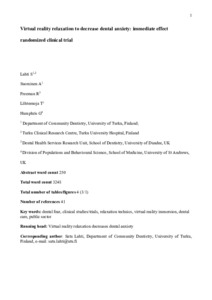Virtual Reality Relaxation to Decrease Dental Anxiety: Immediate Effect Randomized Clinical Trial
S. Lahti. A Suominen; R. Freeman; T. Lähteenoja; G. Humphris
https://urn.fi/URN:NBN:fi-fe2021042825357
Tiivistelmä
INTRODUCTION: Dental anxiety is common and causes symptomatic use of
oral health services.
OBJECTIVES: The aim was to study if a short-term virtual reality intervention
reduced pre-operative dental anxiety.
METHODS: Randomized controlled single-center trial was conducted
with two parallel arms: Virtual Reality Relaxation (VRR) and Treatment As Usual
(TAU) in a public oral health care unit. VRR group received a 1–3.5 minute 360°immersion
video of a peaceful virtual landscape with audio features and sound supporting
the experience. TAU groups remained seated for 3 minutes. Of the powered sample
of 280 participants, 255 consented and had complete data. Total
and secondary gender specific mixed-effects linear regression models were
completed for the post-test dental anxiety
(MDAS total score) and its two factors (Anticipatory and Treatment-related
dental anxiety) adjusted for the baseline (pre-test) MDAS total and factor
scores and age taking into account the effect of blocking.
RESULTS: Total and anticipatory dental anxiety decreased
more in VRR compared to TAU groups (β -0.75 p<.001 for MDAS total score; β -0.43 p<.001 for
anticipatory anxiety score) in patients of primary dental care
clinic. In females dental
anxiety decreased more in VRR compared to TAU group for total MDAS score (β
-1.08 p<.001) and treatment-related dental anxiety (β -0.597 p=.011).
Anticipatory dental anxiety decreased more in VRR compared to TAU group both in
males (β -0.217, p<.026) and females (β -0.498, p<.001).
CONCLUSION: Short application of VRR
is both feasible and effective to reduce preoperative dental anxiety in public
dental care settings. (ClinicalTrials.gov NCT03993080)
Kokoelmat
- Rinnakkaistallenteet [27094]
